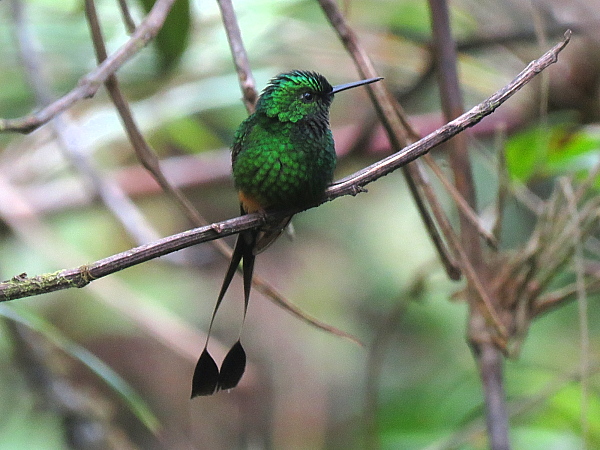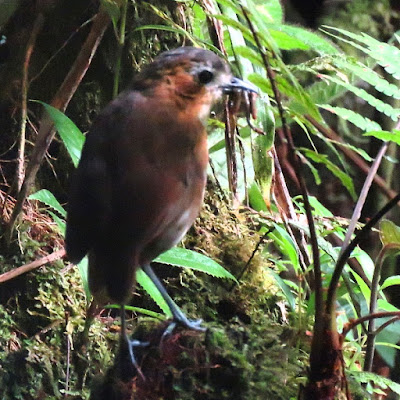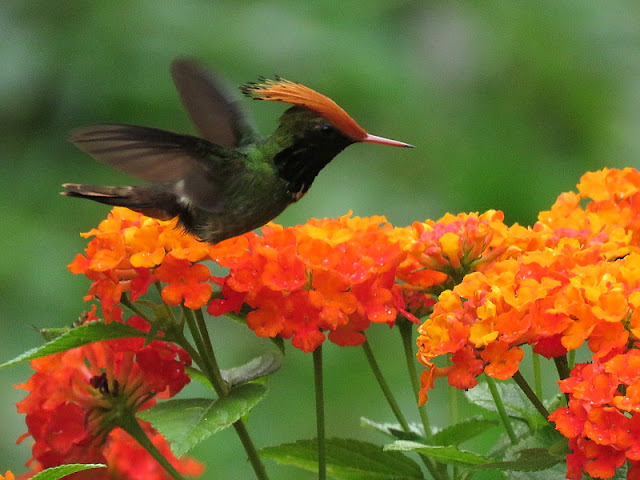This is the second of four posts covering my perspective of a very enjoyable trip to Northern Peru with Mike Catsis, Chris Gooddie, Nick Preston and our excellent guide Juvenal CCahuana Mirano (Juve). It is illustrated with some
variable quality and often heavily cropped photos of mine taken with a Canon SX60
Bridge Camera, supplemented by some better ones taken by Chris using a
Canon DSLR & lens combination that I could hardly lift. The 5"x3"
blog format (7"x5" at a push) hides the shortcomings of my images
whereas most of Chris's would make excellent screen savers.
We had flown to Trujillo where we'd met Juve and visited Sinsicap, Rafan, Bosque Pomac, Quebrada El Limon, Abra Porculla, Tamborapa and Gocta. In five days of birding I had seen 50 new birds ...
03 July. We left at 05:00 to drive to the start of the Rio Chido trail in the village of San Lorenzo. We
stopping briefly for some owling on the way but the road was busy pre-dawn and we
had no luck. We turned off the main road as it was getting light and followed a
dirt track which steadily climbed up through mainly open country and pastures.
Remnant forest could be seen on the ridges high above us. We parked in the
village soon after 07:00 and Juve fried some eggs. It was cold as we waited for
the sun to rise with few birds in evidence but it soon warmed up when the sun
reached us. We set off up the main trail while Juve cleared away breakfast.
It was an hours steady climb up to the ridge and from the first patch of very
dense bamboo we heard our quarry, Pale-billed Antpitta calling. There was a
convenient narrow trail which we crept down but playback only succeeded in some
of us obtaining any sort of a view as one moved in the bamboo below us. I didn’t
even see a shape move. Juve arrived and fortunately said there was a much
better area further up. We followed him up the ridge trail for an anxious 10
minutes before being off over a fence into an area with less understory. Playback
elicited no response. Juve was fairly shocked by this and we later heard a rumour that seven Pale-billed Antpittas had been collected by a ‘scientific’ expedition a few
weeks earlier. To us, if it were true, there seemed no justification whatsoever. We
climbed higher to another area where a rather secretive bird appeared briefly
following playback. I was badly positioned and although it was in full view it
was facing away from me and I never saw its bill. We tried another area further up and
another bird gave frustrating views, my best of this one were again of it back
on, it turned its head as it hopped away but too quickly for me to see its
bill. Very disappointing. One never likes to miss seeing a bird’s named
feature. More so an antpitta. We were birding against the clock today and
couldn’t spend as long on the trail as we’d’ve liked but a nice Rusty-breasted
Antpitta on the way down improved my mood somewhat. We also saw Rufous-capped Thornbill, Black-throated Toucanet, Rufous-breasted Chat-Tyrant and Scarlet-bellied Mountain Tanager. We were back at the car at
15:30 and after a brief stop in the village to pay access fees drove down to Huembo
for the rest of the day. I spent a very anxious 90 minutes watching rather
inactive hummingbird feeders situated it seemed in the darkest part of the forest. These were the feeders favoured by Marvellous
Spatuletails and we waited anxiously for one to appear. After half an hour or so the others, who had seen the species previously, wandered off to look elsewhere. Fifteen minutes later one finally showed, but its appearance was so brief I couldn’t
get my binoculars on it. Juve went to fetch the others and fortunately it soon
returned, a superb male. It was around for a few minutes but didn’t stop
anywhere long. No photos for me but a brilliant encounter all the same. We had a brief look around, seeing a selection of other hummingbirds including a female Little Woodstar, and left just
before 18:00 and drove over the pass and down the other side to Alto Nieva. On
the way we bought some supplies and had a decent meal in a roadside restaurant.
We arrived at the lodge after a 10 minute walk from the road, Juve parking his
car in a village a few minutes further away. The accommodation was very
comfortable and it looked to be a superb area but no sooner had we arrived than the heavens opened and it rained really heavily. Any ideas of owling were
knocked firmly on the head.
 |
| Field breakfast in the village of San Lorenzo. Having replaced his stolen gas canister Juve was back in business with superb field breakfasts. Little did we realise that his table would be stolen from the roof of the vehicle a few days later ... |
 |
| views from the Rio Chido trail |
 |
| Rufous-breasted Antpitta of the Leymabamba race (photo: Chris Gooddie) |
 |
| heading back down |
 |
| the gate at Huembo |
 |
| what out visit would hopefully be all about |
 |
| male Marvelous Spatuletail at Huembo. One of the world's most outrageous hummingbirds (photo: Chris Gooddie) |
 |
| Chestnut-breasted Coronet at Huembo (photo: Chris Gooddie) |
 |
| Sparkling Violetear at Huembo (photo: Chris Gooddie) |
04 July. We left the lodge with Wilmar at 06:20 to walk up to an
area where Rusty-tinged Antpitta was being fed. We arrived at 06:35 and then
endured a very tense hour when the only action was a very distant call. We’d
been spoilt with our 100% success rate in Ecuador earlier in the year so this came
as quite a blow for me as I’d not seen one before. The bird only came for food
early in the morning although we would have another chance the next day. We
returned to Alto Nieva for breakfast then tried a lower trail with Wilmar where
we after a bit of taping we had good views of both Cinnamon-breasted Tody-Tyrant
and Wing-barred Wood Wren which lifted spirits. Even better was to come as Wilmar
spotted a male Ochre-fronted Antpitta beside the trail, one of our top targets
for the trip. I missed the initial sighting, and the second before it settled in
view. Absolutely brilliant, I even managed some images. We returned to the
lodge and visited the nearby feeders seeing a selection of hummingbirds including
Buff-thighed Puffleg and Rufous-vented Whitetip and a Yellow-throated Tanager.
We then headed for the road and drove up towards the pass to look for Royal
Sunangel without success. After a good field lunch we continued just beyond the
pass stopping to look out over some pastures. Before we could get out of the
car Juve heard White-capped Tanagers calling and several flew away over the
pastures towards a distant palm tree. I was last out of the car and panicking and only just
got onto two flying away. One fortunately landed in the top of the tree and I had a brief
scope view but couldn’t see any colour on the throat before it too flew off. It
then started raining. Not great, a poor view of what had been one of my most
wanted South American birds since 1984 when we’d encountered the late Ted
Parker at the Carpish Tunnel in central Peru and he had alerted us to the sound of one
calling way down in a valley below. The rain didn’t last long and we walked
down the road towards where the tanagers had gone. They appeared to have moved
on but after a short while they flew back into the tall palm where I had decent
scope views. At one stage six were visible in the tree with four lined up along
a horizontal branch but by the time I thought to take photos only two remained
on view. They started flying off and Mike counted seven. For me one of the trip
highlights after so long of hoping to see them (and failing previously in
Colombia and Ecuador). We birded back along the road a short way seeing a smart pair
of Lulu’s Tody-Flycatchers before returning to Alto Nieva at about 16:00. We
soon set off to a feeding area for Ochre-fronted Antpitta. We retraced our
steps to where we’d seen the male and then climbed up for 5-10 minutes to where a female, probably its mate, often came in to worms. Having seen the male earlier this should have been a stress free affair but I was still tense. Antpittas are just so good to see. We were on the point of giving up when
the female appeared and gave successively better and better views, ending up at almost touching distance although by now the light wasn’t
great. It was absolutely superb and incredibly tame. Definitely my bird of the
trip. We returned just before 18:00 and birded around the lodge for a short
time before setting off owling with Kenny. It was a stiff 20 minute climb to a
Long-whiskered Owlet territory. The weather was good but despite playing
recordings for half an hour we had no response. We climbed further up the trail to
a higher territory where the process was repeated with the same outcome. There
were three territories on the reserve and visits to look for them were alternated so as not to cause
too much disturbance to any one. Weather permitting we had another change but it took a
bit of the shine off the day. We went back down the trail to an area for Cinnamon
Screech Owl and played recordings. At the point of giving up Kenny heard a
response. He played the tape a bit longer then shone his torch directly onto
the bird. Very impressive, more so as it just sat there staring back at us. Maybe not the owl we had been most hoping for but a brilliant end to the day never the less, we returned to the lodge for a good meal.
 |
| Bar-winged Wood Wren at Alto Nieva (photo: Chris Gooddie) |
 |
| male Ochre-fronted Antpitta at Alto Nieva |
 |
| it wasn't as good at hide-and-seek as it thought |

 |
| Golden-headed Quetzal at Alto Nieva (photo: Chris Gooddie) |
 |
| Peruvian Racket-tail at Alto Nieva |

 |
| another great hummingbird |
 |
| Speckled Hummingbird at Alto Nieva |
 |
| Violet-fronted Brilliant at Alto Nieva |
 |
| aptly named when it caught the light |
 |
| Rufous-tailed Tyrant at Abra Patricia |
 |
| distant White-capped Tanagers at Abra Patricia, there had been four sat on the frond a moment before |
 |
| a species I had been wanting to see for many years, it did not disappoint |
 |
| they were distant but views were nice through my telescope - one of the few times I felt it was worth taking |
 |
| Lulu's Tody Flycatchers at Abra Patrcia - active birds and poor light is not a good combination for my sort of photography |
 |
| the best I managed, Chris did a lot better below |
 |
| Lulu's Tody Flycatcher at Abra Patrcia (photo: Chris Gooddie) |
 |
| female Ochre-fronted Antpitta at Alto Nieva |
 |
| she immediately became my bird of the trip and was unlikely to be toppled |
 |
| she often did a brilliant little shimmy, something other Grallaricula antpittas do |

 |
| amazing views of a brilliant bird |
 |
| Cinnamon Screech Owl at Alto Nieva |
 |
| Cinnamon Screech Owl (photo: Chris Gooddie) |
 |
| Cinnamon Screech Owl (photo: Chris Gooddie) |
05 July. We had breakfast at 06:00 and left with Kenny at 06:30 to
revisit the Rusty-tinged Antpitta feeding area. We arrived at 06:45 and the
antpitta soon came in, much to my relief. We returned to the lodge and drove up
to Owlet Lodge at the pass. We arrived just too late to see a Chestnut Antpitta
being fed and wandered around for a couple of hours hoping one might hop out
onto a trail. None did and little else was seen other than the usual
hummingbirds on their feeders. We paid our entrance fees which Juve negotiated
to include a return visit for the antpitta in the morning. We tried another
roadside cliff area where Juve had previously seen Royal Sunangel. He had a
brief view of one below the road and I concentrated on that area without seeing
anything. Chris then spotted a male high above us on the cliffs opposite.
Annoyingly I’d left my telescope in the car and Juve kindly fetched it
for me but the bird promptly disappeared. I then managed to break one of the legs on my
tripod – the third trip I’d taken it on and the second time it had let me down as
the head’s quick release had broken in Bolivia. We walked sections of the road
after a field lunch but it was very busy with many heavy lorries. Neither
pleasant nor particularly safe, as passing police warned us. We saw returned to
Alto Nieva at 16:00 and spent almost an hour at the feeders before heading up
into the forest with Kenny and Wilmar. The antpitta had been excellent and we had seen Sword-billed Hummingbird, Black-throated Tody-Tyrant, Scale-crowned Pygmy-Tyrant, Green & Black Fruiteater and Yellow-scarfed and two more White-capped Tanagers but the day was likely to be judged on our success or otherwise owling. We reached the Long-whiskered Owlet site
we’d tried first the previous evening and waited quietly and rather anxiously
until dark. Kenny played a recording and one immediately responded. It moved a
couple of times, once buzzing right past my head, too fast for me to detect
anything in the dark, before calling again. On the last occasion an attempt to
lamp it failed and it fell quiet. Had we blown it? We waited for an extremely tense 15-20 minutes listening
desperately to silence and were just about to leave to try another site when it
called again from further up the trail. Juve and Wilmar quickly pursued it and
as we arrived were trying to find it in the spotlight. Kenny could see it from
behind us and started giving them directions ‘derecha, derecha’. It was perched back
on at about twice head height but then with rapidly whirring wing beats flew almost vertically to land towards the top of the tree. It gave reasonable if
somewhat distant and mainly back on views for several minutes. A bit disappointing perhaps, compared to some images I've seen of them, but we would have more than settled for the views a few minutes earlier. Much relief all
round and a good end to an at times frustrating day.
 |
| Grass-green Tanager at Owlet Lodge |
 |
| Yellow-breasted Brushfinch at Owlet Lodge |
 |
| coffee plantation above Aguas Verdes |
 |
| remnant forest always seemed to be on the next ridge |
 |
| Zimmer's or Northern Chestnut-tailed Antbird (photo: Chris Gooddie) |
07 July. We had a ‘field breakfast’ in the street outside Norbil Becerra's house
- a local farmer who had set up the Reserva Arena Blanca feeding station in a block of forest outside
of town. We left with him for the 10 minute drive to his plot. Here he’d built
an impressive hide looking down on a feeding station elaborately refilled by a long pipe
down which he dispatched seed. It worked brilliantly and we saw Little Tinamou, Rufous-breasted Wood Quail, Ruddy Quail Dove,
Grey-necked Wood Rail and Black Agouti. After an hour we walked on a
short distance to an equally impressive hummingbird garden. We saw 11 species
of hummingbird including a superb male Rufous-crested Coquette (now my favourite hummingbird?), Amethyst
Woodstar and Blue-fronted Lancebill. England v Sweden was on live in the hotel
when we returned and delayed our departure much to Nick’s annoyance. We drove
down towards Moyobamba stopping to bird in an area of paddies near Rioja. We
were at a much lower elevation and it was very hot under an almost cloudless sky. We saw Slender-billed Kite, Black-capped Donacobius and Pale-eyed Blackbird. We continued to Moyobamba
stopping at a pool on the outskirts to look unsuccessfully for Masked Duck. We
continued around town to Casa de Seisa near Wakanki. Casa de Seiso was very
pleasant lodge run by a Japanese couple. We left our bags and drove into town
for a late lunch before successfully returning to the Masked Duck pool.
Cinereous-breasted Spinetails were calling nearby and we tracked one down but only
Nick saw it perched, the rest of us having to settle for flight views. We
continued to the imposing Morro de Calzado as the light started to fade and
climbed a short distance through dry and seemingly birdless forest. A Rufous
Nightjar called at dusk and came in to do a single pass in response to
playback. I didn’t see much more than a wing. Walking the road a short way
before leaving produced a Stygian Owl high in a distant tree. We returned for
an excellent meal, my fears it might have included raw fish were completely
unfounded. A walk around after dark failed to produce any nightbirds.















































































































No comments:
Post a Comment
Note: only a member of this blog may post a comment.